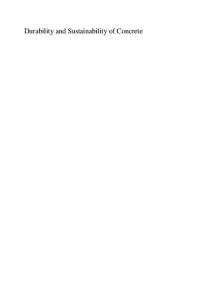Effect of the ITZ Damage on Durability of Reinforced Concrete in Chloride Environment
- PDF / 366,797 Bytes
- 6 Pages / 414.72 x 648 pts Page_size
- 56 Downloads / 328 Views
reinforcement (Fig. 1). Concrete composition and its compressive strength at 28 days are given in Table 1. The types A and B correspond to a 4 cm maximum and 1 cm minimum concrete cover respectively, in accordance with French regulations at the time of manufacturing (1983) '. The type A beams respect the international requirements (E.C.2) for storage in an aggressive environment. The type B beams do not respect the international requirements for storage in an aggressive environment, because one of the aims of this study is to improve actual requirements to know if these are justified. These beams are superimposed upon one other and separated by metallic wedges. Their construction is in compliance with current standards. These reinforced concrete elements are exposed, in a loading state, to salt fog. For each specimen, the concrete composition is: 5/15 mm 1220 kg/m3 rolled gravel (silica + limestone) 820 kg/m 3 0/5 mm sand 400 kg/-3 Normal Portland Cement: HP (high perform.) 200 kgim3 water Table 1: Concrete composition Water content was adjusted to obtain 7 cm in slump-test for every concrete mixture. The average cylinder specimen compression stress was measured at 45 MPa at 28 days. Chemical composition of cement SiO7 21.4
% weight
A170,1 6
Fe,?O,; 2.3
CaO 63
MgOI 1.4
SO3
I Na9 O 0.5
qNNN
H.
220,2
2
0 22
0 02 20122 0, 20,220,220,220 2
2 0, , 2202 20,220,22 HA 6
IU
HA 14 stirrups
P6 mm
14 stirrups 4)8 HA 12 HA 16 2000N
SI 15
I
20 2 2012 ]202220122 0 202O2 0 2 ý2k8010ý2k 2 12o022012 Fig. 1 : Lay-out of reinforced concrete beams PENETRATION OF CU IONS INTO THE CONCRETE Either exogeneous or endogeneous, the cl- ions inside concrete are of two types: bound and free. The bound cl- ions are fixed either by adsorption or by chemical reactions with some cement components. In the latter case, what results is monochloroaluminate of calcium C3ACaCI2 ,10H20.
466
The free cl- ions can migrate into the concrete and reach the reinforcement and are responsible for the corrosion of the reinforcement. Thus, the method used to measure the chlorides in concrete must allow the distinction between bound cl- ions, harmless to the steel, and free cl- ions. The selective separation can be achieved by using differences between chlorides solubilities. The free cl- ions can be extracted by cold water: this is not the case, under certain conditions, for the bound cl- ions. Consequently, the samples must be taken out from the beams using a dry process so as to avoid any leaching. For this, the sampling is done by regular drilling at a depth of 10 mm. The powder obtained from this process is carefully collected and stored in a sealed container before being measured. The choice of the localization of the various samplings has been dictated by the wish to demonstrate the influence of different parameters, such as the intensity of the mechanical stress applied and the loading state of the concrete. Effect of strain state
10-2 CI
14
18 16
in % of Concrete
12 B2 Tensile zoi
14 10
12 10
8
8
6
B2 Tensile z e ( free)
Data Loading...











